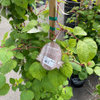Azaela chloritic because of deodar cedar?
spazzycat_1
15 years ago
I have two kurume azaelas that flank a path. One does fine, but the opposite one is in decline (chloritic and lots of dieback from the drought last year). The only difference is that this azaela gets a bit of overhang from a deodar cedar. I sampled the PH and it was slightly alkaline. Could the dropped needles from the deodar be causing the soil to be alkaline? I always thought that evergreen needles would tend to have an acidifying effect.




tsugajunkie z5 SE WI ♱
Dibbit
spazzycat_1Original Author